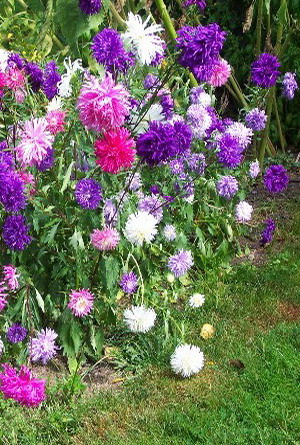
Astra as a flower is widely distributed in nature, belongs to the Compositae family, and its genus includes more than 600 species. It grows in the steppe, mountain and forest regions.
- Origin: China.
- Flowering: spring – late autumn, depending on the variety.
- Watering: as needed. In drought and growing season – plentiful.
- Propagation: vegetatively and by seeds.
- Pests: plow slug, common earwig, sunflower moth, meadow bug, spider mite, bud aphid and scoop.
- Diseases: fusarium, black leg, rust and jaundice.
Description: Aster flower is an annual or perennial plant, some species of which can reach 2m in height. It can grow both as a single flower and as a whole bush. The stems of the culture are erect, strong with elongated and slightly serrated leaves. Astra flower has a root system with horizontal, thin and highly branched roots. Flowers are inflorescences, consisting of a large number of small flowers, in which the petals can be of different colors: purple, purple, blue, pink and white. In the very center of the flower is a yellow “eye” consisting of tubular flowers, in which seeds with an appendage are formed. Asters have a long flowering that begins in late spring and lasts until late autumn, persisting even with slight frosts. Depending on the flowering periods, all asters are divided into 2 groups: spring-flowering – plants with non-branched stems and the 1st, located at the top of the flower basket; summer – autumn flowering – powerful, tall plants with branched stems and diverse flower baskets collected in large paniculate or umbellate inflorescences.
Asters – growing in the country
Astra grows best on fertile light soils with close to neutral acidity, in open or well-lit areas. The introduction of manure under the crop is not allowed, since there is a high probability of being affected by Fusarium. For this reason, the cultivation of asters cannot be carried out in the country, where tulips, gladioli, carnations previously grew. The best predecessors are calendula and tagetes. It is recommended in the fall, before deep digging of the soil per 1 m 2 , to add 2-3.5 kg of compost or humus, and before spring digging, 25-45 g of superphosphate, 15-20 g of potassium salt and 15-20 g of ammonium sulfate.
Almost all varieties and varieties are easily propagated vegetatively and with the help of seeds. Due to the dense shell, the seeds tolerate adverse conditions well, maintaining germination for 2-3 years. Seeds are sown not only in spring, but also on the eve of winter in pre-prepared grooves – in this case, asters are 3 times less likely to be affected by fusarium.
Astra is a cold-resistant crop that tolerates frosts down to -3-4 ° С. Plants obtained from seeds during winter sowing in open ground bloom 1.5-2 weeks later than those planted by seedlings, while they have more abundant and prolonged flowering, lasting until frost.
Asters – care in the garden
Caring for asters is quite simple, as they are unpretentious, but on dry dry days they require abundant watering, while they do not tolerate overcomplicated soil. On well-fertilized soil, with normal watering and fertilizing, the aster will bloom until late autumn. You need to feed the culture with mineral fertilizers. Organic fertilizers – chicken manure in a ratio of 1:20 is used only on poor soils. The first top dressing should be carried out 1.5-2 weeks after the asters are planted in the ground, when the plant adapts. The next 2 top dressings are carried out during the period of budding and flowering.
Asters – perennial flowers
Asters are perennial flowers with dense foliage 25 to 200 cm high, with white, pink, blue, purple or crimson flowers. Flowers with a diameter of 1-6 cm can be double, semi-double and simple. Astra is divided by flowering time into early (May – June), summer (July – August) and autumn (September – November).
Perennial asters should be grown in open areas well-lit by the sun, since when grown in partial shade, the likelihood of powdery mildew is high. To prevent the disease, before flowering, 2 times with an interval of 12 days, treat the flowers with the Topaz preparation with a composition of 4 ml per 10 liters of water, and in the fall, after flowering, with copper sulfate in a ratio of 10 g per 10 liters of water.
The most favorable for perennial asters are medium-heavy, nutritious, loamy and neutral soils. Throughout the season, it is necessary to regularly loosen the soil to prevent the formation of a crust and remove weeds. You need to water as needed, and during a drought and during an intensive growing season, it is plentiful.
Asters – varieties for every taste
A large family of asters can be divided into the most popular and well-known species and varieties of asters:
View – New Belgian Aster (Aster novi-belgii) – from 50 to 150 cm high with an upright stem, inflorescences are collected in a panicle at the ends of the shoot with a diameter of 2-4 cm, blooming in September – October.

Popular varieties:
Beechwood Rivel (Purple Red)
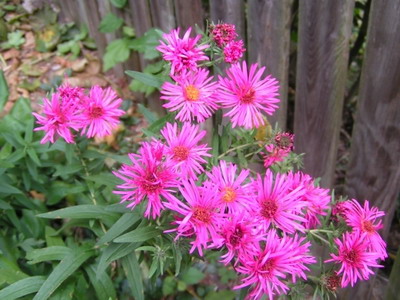
Dick Ballard (pink)

Herbert Wunder (white)
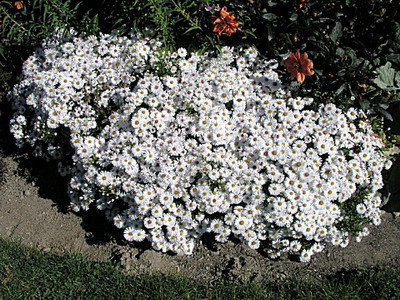
Mount Everest (white)
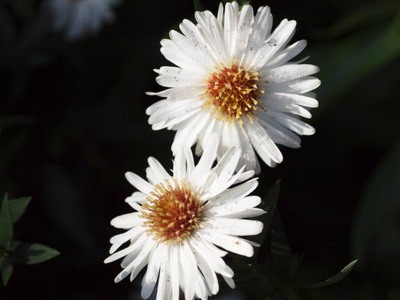
Aster novi-belgii ‘Blue Danube’ (blue)
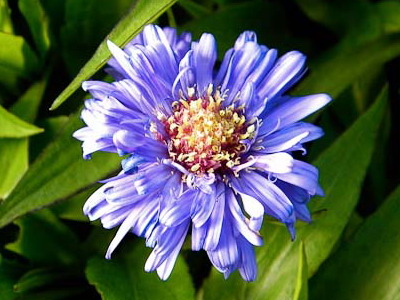
Oktoberfest (light blue)
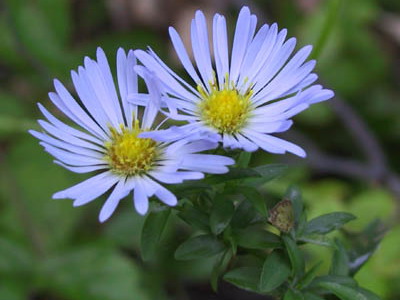
Helsie (lavender)

Weiser Elephant (white)
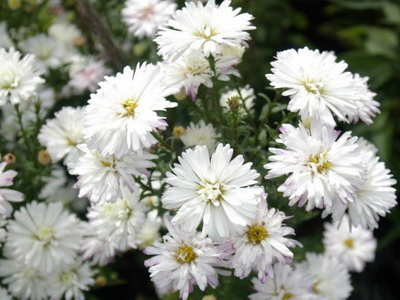
Arctic (white)

Popular types:
New England or American aster (A.Novae-Angliae L) – up to 2 m high. Numerous lanceolate stems with leaves and inflorescence 3-4 cm in diameter. Varieties: Constance (dark purple), Dr. Eckener (red-violet) and Bars Pink (golden and brown).
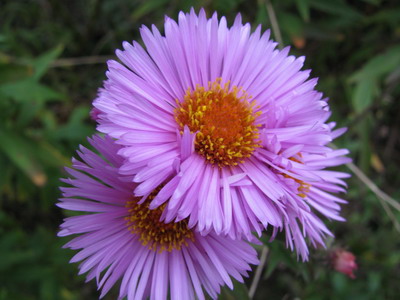
Shrub aster (A. dumosus L) – is a compact shrub up to 50 cm tall with dark green lanceolate leaves and an inflorescence corymb. Varieties: Blue Bouquet (blue), Venus (purple pink), Lady Henry Muldock (pink carmine) and Diana (pink).

Stonecrop aster (A. sedifolius L) – up to 40 cm high, inflorescence small baskets are collected in a panicle of light purple and pink.
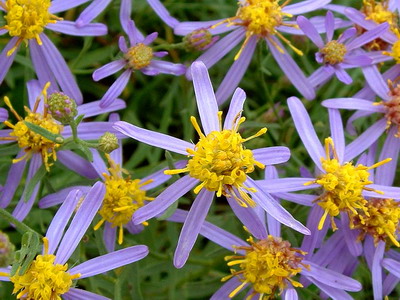
Italian aster (A. amellus L.) – up to 60 cm high, with an inflorescence corymb 4 cm in diameter of lavender, pink, lilac and blue.

Bluish aster (A. subcoeruleus T. Moore) – up to 35 cm tall with strong stems and lanceolate leaves. Large inflorescences of purple and lilac color.

Alpine aster (Aster alpinus L.) – a plant up to 40 cm high and single inflorescences 4-5 cm in diameter. Varieties: Superbus (blue), Goliath (light purple), Alba (white) and Dunkle Schene (dark purple).

Why asters turn yellow
The reason why asters turn yellow is Fusarium or Fusarium wilt – a disease caused by one of the fungi of the Fusarium genus. As a rule, adults are already affected during budding or the beginning of flowering. On the one hand, the infected plant begins to fade gradually, the bud leans, the leaves droop. A brown-brown crack appears on the stem on the same side, the leaves turn yellow, and the flower quickly dies. Radical control measures do not yet exist, but spraying with the Baikal EM-1 solution helps.
Another reason why asters turn yellow is asters jaundice, a disease caused by a virus. First, the leaf blade turns yellow along the veins, and then extensive leaf chlorosis occurs. The buds stop growing, turn green, and there is a suppression of the growth of the whole plant. Carriers are cicada and aphids.
Control measures: spraying plants with solutions of pyrimor, intavir, actellik and pyrethrum, as well as burning the affected plants.







